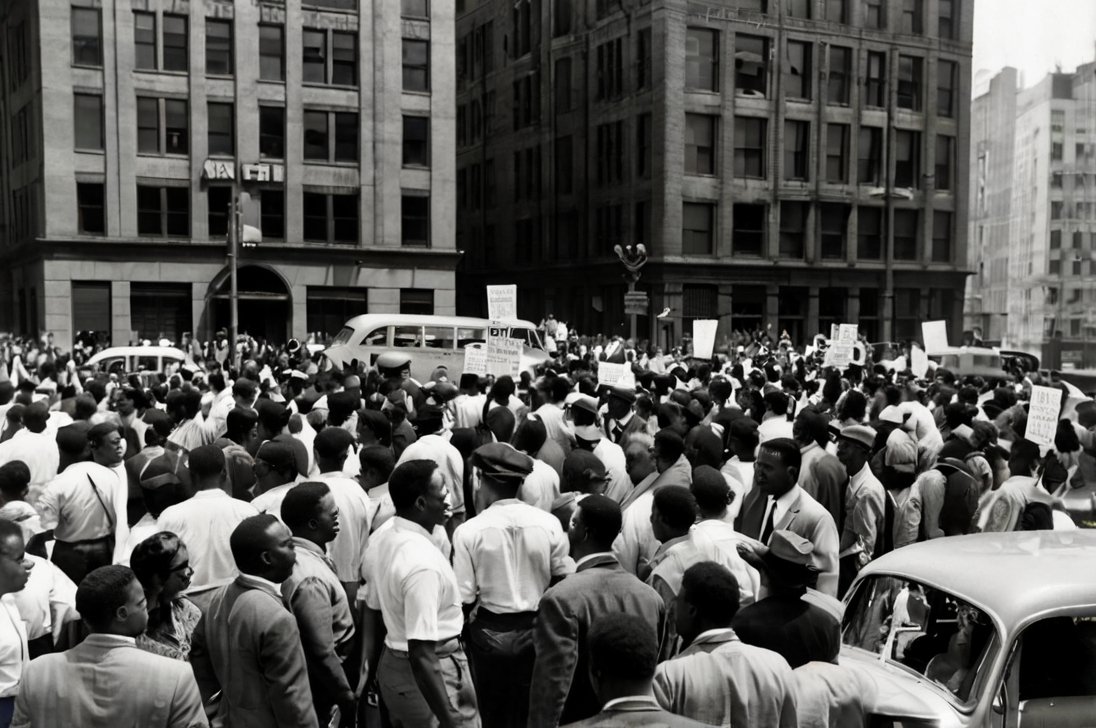
The Civil Rights Movement was a pivotal era in American history, marked by a collective effort to end racial segregation and discrimination against African Americans.
It spanned the 1950s and 1960s, a time when courageous individuals and organized groups challenged systemic racism through activism and legal challenges.
In this blog post, we will explore the historical context, key events, significant figures, and lasting impact of the Civil Rights Movement.
Historical Context
The roots of the Civil Rights Movement lie in the deep-seated segregation and discrimination that plagued the United States for centuries.
Segregation and discrimination
For many years, the United States struggled with segregation and discrimination against African Americans.
This meant separating whites and blacks in public places like schools, restaurants, and buses.
The Supreme Court’s decision in Plessy v. Ferguson in 1896 allowed this segregation to continue, even though facilities for blacks were often inferior.
African Americans faced discrimination in many aspects of life, including education, jobs, housing, and voting rights.
This unfair treatment created a cycle of poverty and inequality that fueled the Civil Rights Movement.
- Read also: Unveiling History: Civil War vs Revolutionary War
- Read also: A Cultural Explosion: Facts About The Harlem Renaissance
Brown v. board of education
A major turning point came in 1954 with the Supreme Court’s decision in Brown v. Board of Education.
This case overturned the Plessy v. Ferguson ruling by declaring that segregating public schools based on race was unconstitutional.
The Court recognized that separate schools for blacks and whites were not equal, paving the way for efforts to desegregate all public facilities.
This decision inspired civil rights activists to challenge other forms of racism embedded in laws and institutions across the country.
Rosa Parks and the Montgomery bus boycott
On December 1, 1955, Rosa Parks, a seamstress and member of the NAACP, refused to give up her seat to a white person on a bus in Montgomery, Alabama.
Her courageous act led to her arrest and sparked the Montgomery Bus Boycott.
African Americans in Montgomery, led by Martin Luther King Jr., organized a year-long protest where they refused to ride the buses.
The boycott ended with the Supreme Court ruling that segregation on public buses was illegal.
This victory showed the power of nonviolent protest and became a symbol of resistance in the fight for civil rights.

Key Events and Activists
Martin Luther King Jr.
Martin Luther King Jr. was a central leader in the Civil Rights Movement.
As a Baptist minister, he believed in peaceful protests and civil disobedience to fight against racial injustice.
Inspired by Mahatma Gandhi’s teachings, King became known for his powerful speeches, including the historic “I Have a Dream” speech given at the 1963 March on Washington.
His words and actions inspired millions of people to join the fight for equality and justice.
Freedom rides and sit-ins
The Freedom Rides, starting in 1961, were journeys across the Southern United States where both black and white activists rode buses together to challenge segregated bus terminals.
Organized by groups like the Congress of Racial Equality (CORE), these rides faced violent opposition but drew national attention to segregation in interstate travel.
They eventually led to federal laws enforcing desegregation in public transportation.
Sit-ins were another powerful form of protest.
In 1960, African American students in Greensboro, North Carolina, peacefully occupied seats at segregated lunch counters, sparking a wave of sit-ins across the South.
These protests aimed to end segregation in public places and drew support from people of all races who believed in equal rights.
March on Washington
The March on Washington for Jobs and Freedom took place on August 28, 1963, in Washington, D.C.
Over 250,000 people, black and white, gathered to demand equal rights and economic opportunities for African Americans. It was one of the largest rallies for human rights in United States history.
Martin Luther King Jr.’s “I Have a Dream” speech at this event became a defining moment for the Civil Rights Movement, inspiring hope and unity in the fight against racial discrimination.

Global Impact
Inspiration to other movements
The Civil Rights Movement had a profound global impact, inspiring similar movements worldwide.
The African American struggle for equality resonated with oppressed groups globally, including the Dalit movement in India, which sought to end caste discrimination.
The principles of nonviolent resistance and civil disobedience became powerful tools for social change in various contexts.
International support
International solidarity played a crucial role in the Civil Rights Movement.
Countries around the world condemned racial segregation and supported the fight for equality.
The global attention put pressure on the U.S. government to address civil rights issues, highlighting the universal appeal of the movement’s goals.
Strategies and Tactics
Nonviolent resistance
Nonviolent resistance was a cornerstone of the Civil Rights Movement.
Inspired by Gandhi’s philosophy, activists used peaceful protests, boycotts, and civil disobedience to challenge unjust laws and practices.
This approach not only highlighted the moral high ground of the movement but also drew national and international attention to the cause.
Boycotts and demonstrations
Boycotts and demonstrations were effective strategies in the Civil Rights Movement.
The Montgomery Bus Boycott, for example, demonstrated the economic power of African Americans and led to significant legal victories.
Demonstrations, such as the Selma to Montgomery marches, highlighted the demand for voting rights and resulted in the passage of the Voting Rights Act of 1965.
Litigation and legal challenges
Legal challenges were another vital aspect of the movement.
Landmark cases, such as Brown v. Board of Education, played a pivotal role in dismantling institutional racism.
Organizations like the NAACP Legal Defense and Educational Fund worked tirelessly to challenge discriminatory laws and practices in the courts.

- Read also: A Look Back in Time: The Most Impactful American History Events
- Read also: How Many U.S. Presidents Have Been Assassinated?
Conclusion
The Civil Rights Movement was a transformative period in American history, characterized by the relentless pursuit of justice and equality.
Through the efforts of brave individuals and organized groups, significant strides were made in ending racial segregation and discrimination.
The legacy of the movement continues to inspire social justice movements worldwide, reminding us of the power of collective action and the enduring quest for human rights.



